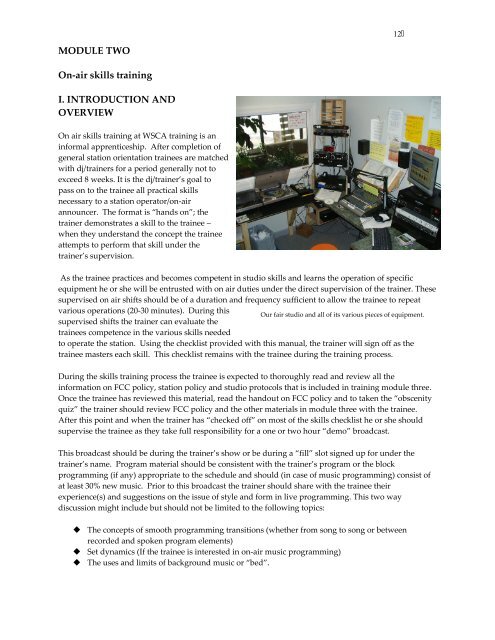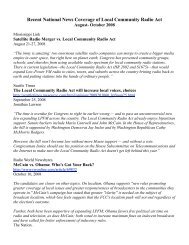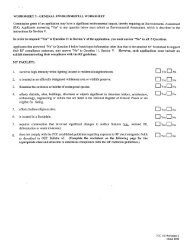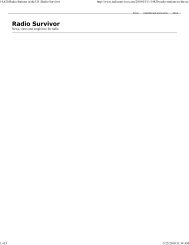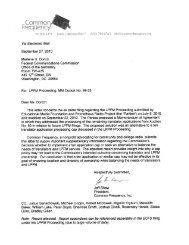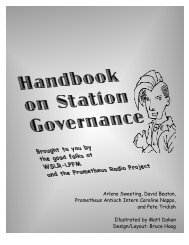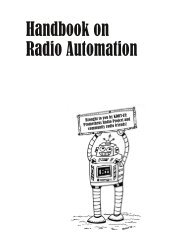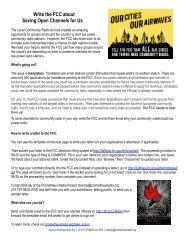WSCA Station Handbook and Training Manual - Prometheus Radio ...
WSCA Station Handbook and Training Manual - Prometheus Radio ...
WSCA Station Handbook and Training Manual - Prometheus Radio ...
You also want an ePaper? Increase the reach of your titles
YUMPU automatically turns print PDFs into web optimized ePapers that Google loves.
12<br />
MODULE TWO<br />
On‐air skills training<br />
I. INTRODUCTION AND<br />
OVERVIEW<br />
On air skills training at <strong>WSCA</strong> training is an<br />
informal apprenticeship. After completion of<br />
general station orientation trainees are matched<br />
with dj/trainers for a period generally not to<br />
exceed 8 weeks. It is the dj/trainer’s goal to<br />
pass on to the trainee all practical skills<br />
necessary to a station operator/on‐air<br />
announcer. The format is “h<strong>and</strong>s on”; the<br />
trainer demonstrates a skill to the trainee –<br />
when they underst<strong>and</strong> the concept the trainee<br />
attempts to perform that skill under the<br />
trainer’s supervision.<br />
As the trainee practices <strong>and</strong> becomes competent in studio skills <strong>and</strong> learns the operation of specific<br />
equipment he or she will be entrusted with on air duties under the direct supervision of the trainer. These<br />
supervised on air shifts should be of a duration <strong>and</strong> frequency sufficient to allow the trainee to repeat<br />
various operations (20‐30 minutes). During this<br />
Our fair studio <strong>and</strong> all of its various pieces of equipment.<br />
supervised shifts the trainer can evaluate the<br />
trainees competence in the various skills needed<br />
to operate the station. Using the checklist provided with this manual, the trainer will sign off as the<br />
trainee masters each skill. This checklist remains with the trainee during the training process.<br />
During the skills training process the trainee is expected to thoroughly read <strong>and</strong> review all the<br />
information on FCC policy, station policy <strong>and</strong> studio protocols that is included in training module three.<br />
Once the trainee has reviewed this material, read the h<strong>and</strong>out on FCC policy <strong>and</strong> to taken the “obscenity<br />
quiz” the trainer should review FCC policy <strong>and</strong> the other materials in module three with the trainee.<br />
After this point <strong>and</strong> when the trainer has “checked off” on most of the skills checklist he or she should<br />
supervise the trainee as they take full responsibility for a one or two hour “demo” broadcast.<br />
This broadcast should be during the trainer’s show or be during a “fill” slot signed up for under the<br />
trainer’s name. Program material should be consistent with the trainer’s program or the block<br />
programming (if any) appropriate to the schedule <strong>and</strong> should (in case of music programming) consist of<br />
at least 30% new music. Prior to this broadcast the trainer should share with the trainee their<br />
experience(s) <strong>and</strong> suggestions on the issue of style <strong>and</strong> form in live programming. This two way<br />
discussion might include but should not be limited to the following topics:<br />
The concepts of smooth programming transitions (whether from song to song or between<br />
recorded <strong>and</strong> spoken program elements)<br />
Set dynamics (If the trainee is interested in on‐air music programming)<br />
The uses <strong>and</strong> limits of background music or “bed”.


